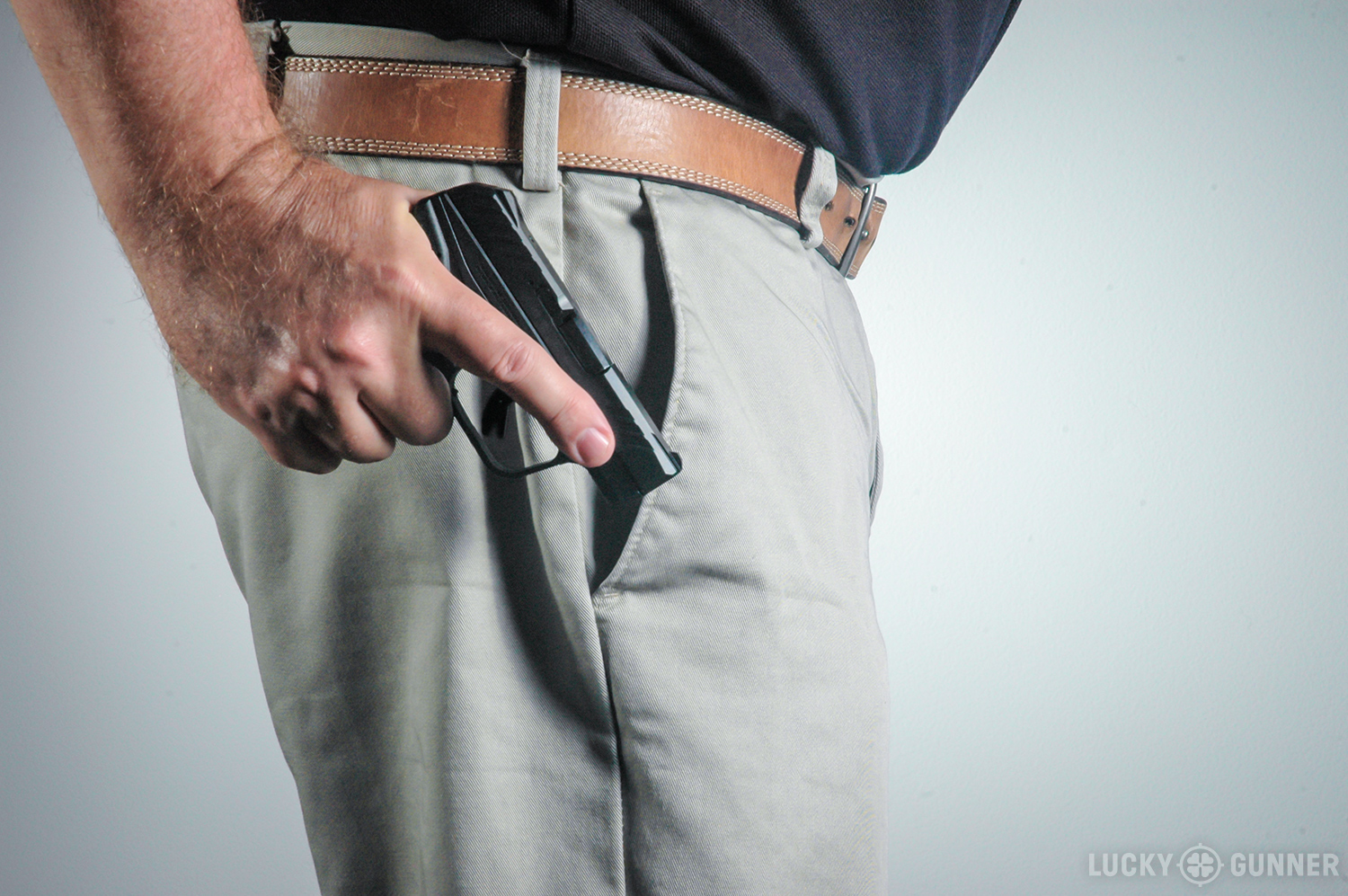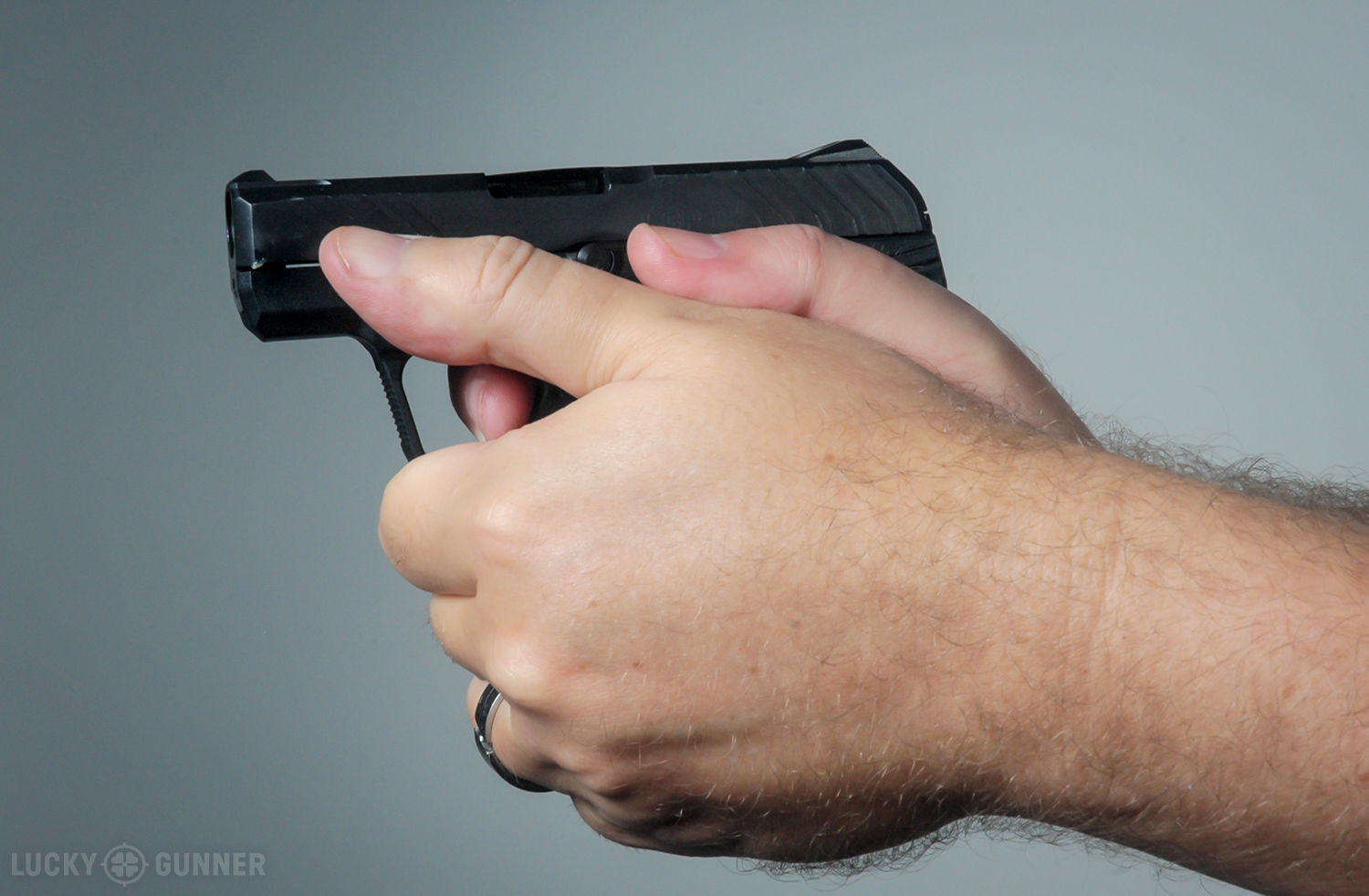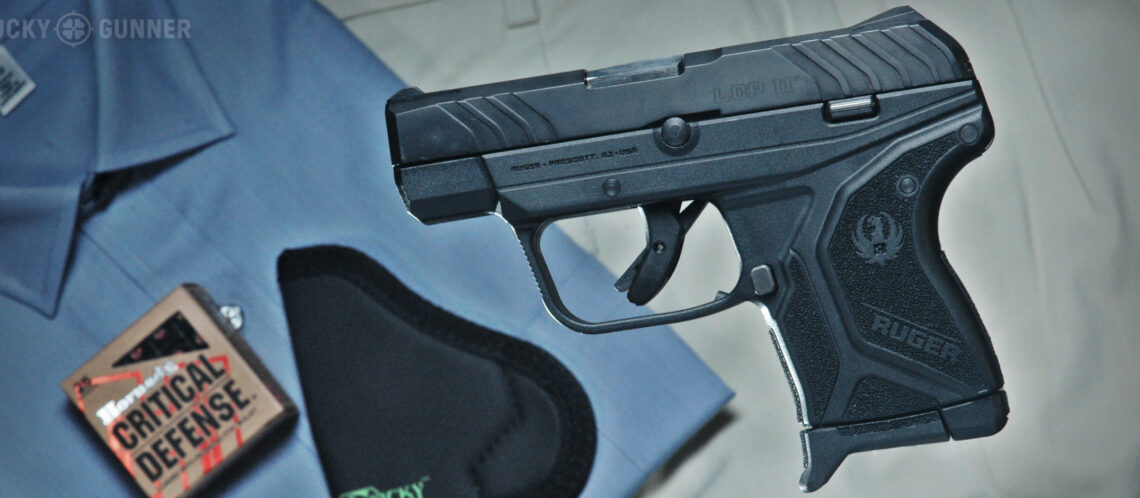In a perfect world, we could walk around all day with the gun of our choice on our person, either in open sight or concealed, and no matter how large it is, no one would look twice or say one word about what we’re doing.
But we don’t live in that perfect world, and there are times when the need to be discreet will outweigh the need to carry as much firepower as possible. On those occasions, we need to take more care than usual making sure our defensive gun is not visible to others. In such circumstances, I prefer to carry a small pistol in my pocket over other ways to carry a gun.
It’s hard to define exactly what a “pocket pistol” is because, if you have a big enough pocket, even a full-sized .44 Magnum revolver could be considered a “pocket pistol”. However, for the purposes of this article, we’ll set the standard as something that can slip into the front pocket of a pair of men’s dress pants and won’t cause a print any bigger than a wallet or a smartphone would.
There are many different ways to carry a gun this size, not necessarily in a pocket. However, when I had a chance to talk with Michael Bane, the host of The Best Defense and other firearms-related shows on the Outdoor Channel, he had some interesting things to say about some of the advantages of pocket pistols and why you would want to carry one in a pocket over alternative ways to carry a small pistol, such as off-body carry.
“Pocket pistols, like the Ruger LCP II or LCR and the Kahr P380 or Smith and Wesson Bodyguard are a great option for the times you can’t carry a larger gun or the situation around you prevents carrying a larger gun. They’re also good for around the house. For instance, it’s my everyday routine to slip a small .380 into my strong-side pocket when I get dressed in the morning and then move it to my weak side if I put on a larger gun later.”

“Also,” Michael said, “If you’re the type of person who constantly forgets where they left their car keys, off-body carry probably isn’t for you. You need to keep track of your gun pretty much 24/7, and leaving it in a bag in a restaurant restroom is not a good idea for everyone involved. Whatever you do,” he said, “make sure that your gun is carried in a holster of some kind that is designed from the ground up to hold a pistol. The pockets on your pants are designed to hold car keys and loose change, not a gun.”
Pocket pistols obviously have some drawbacks, but they also do some things do very, very well. Let’s first look at the downsides to carrying around a small gun in your pocket.
Pocket Pistol Disadvantages
Firepower
A small pistol is either going to have a small amount of medium-powered rounds, like the five shots in a typical .38 revolver, larger amounts of smaller-caliber rounds like the six or seven rounds in most small .380ACP semi-automatic pistols, or very few rounds of larger caliber ammunition like what you see in .357 Magnum derringers and similar guns. This presents a problem because we know we need to rely on a certain number of hits that penetrate deep enough into an attacker to stop the threat, and having just a few rounds to work with lessens that chance of enough accurate hits to stop the threat
Sights and Accuracy
A smaller gun is going to have a shorter sight radius, which means you will not be able to quickly aim it with as much precision as you would a longer, bigger gun with similar sights. Also, small guns are harder to hold than larger guns because there is less grip to hang on to. This affects your accuracy in unexpected ways. First off, your hands have a greater chance of shifting around and move as you pull the trigger, affecting your grip and accuracy in subsequent shots. Secondly, pocket pistols weigh less than their larger counterparts, meaning there is less mass to counteract the adverse effects of a bad trigger pull. A 36 ounce 1911 is going to dampen the motion from a bad trigger pull a lot more than an 8.3 ounce Kel-Tec P3AT will (Force = Mass x Acceleration… It’s not just a good idea, it’s the law!) Also, pocket guns tend to have lousy triggers which further affect their accuracy. Long, heavy trigger pulls that reach ten pounds or more are not unheard-of in smaller semi-autos and pocket-sized revolvers, and learning how to tame the heavy trigger in those small guns can be quite a chore.
Recoil (and lots of it)
When I worked behind a gun counter, I was always amazed at how many people assumed that a smaller gun meant less recoil when in reality, the reverse is usually true. A smaller gun will have harsher, more pronounced recoil than a larger gun in the same caliber because there is less mass of the gun to soak up the recoil and less of the gun to hold and help control the recoil. This (often-brutal) fact of physics can be overcome by choosing a gun that shoots lower-powered rounds such as .380ACP or .22 Magnum. However, the chance of finding a pocket gun that handles recoil as well as a larger pistol is pretty much zero, so plan accordingly and practice shooting it a lot.
With all that in mind, what are some benefits of a pocket pistol?
Pocket Pistol Benefits
Portability
Smaller, lighter guns are easier to conceal and carry than larger guns. This is a huge advantage of a smaller gun, and it should not be overlooked. There is a lot to be said for larger guns like the 1911 or a Glock 17, but those guns are not effective self-defense tools if they are not near you when you need them. You know that old cliché that “ A .22 in your hand beats a .45 in your truck”? Well, clichés don’t get to become clichés without an element of truth in them, so plan on carrying something anywhere you can, even if it’s a lower-powered pocket gun.

Discreetness
Because it looks like a formless lump in your pocket, a small pistol in a good holster is really hard to spot, even for trained professionals. We are used to seeing the bumps in people’s pockets from keys, wallets, mobile phones and whatnot, so the bumps caused by a small pistol rarely get noticed or cause alarm.
Speed
One of the advantages of pocket carry is that you can start a potentially violent encounter with your hand on your gun. Sliding our hands into our pockets is a normal, everyday occurrence, and you can dramatically shorten your draw time if you start with your gun already in your hand, rather than having to reach down, clear a cover garment, and then draw your gun.
Evening the Odds With The Right Accessories
Many of the disadvantages of smaller guns can be overcome with add-on accessories for your pistol. Laser sights can compensate for the short sight radius and small sights on most pocket guns, and some pocket pistols offer options for night sights or high-visibility sights, improving your chances of putting rounds on-target when you need them the most. The limited capacity of small semi-automatics can be improved with an extended magazine for an extra one or two rounds, and slip-on rubberized grips can help you get more of your hands on the gun and control recoil more, making it more accurate and easier to shoot.
Is a pocket gun your optimal solution for concealed carry? Probably not. They’re harder to control and carry fewer rounds than larger guns. Because of their small size and higher recoil, they’re not as much fun to shoot as larger guns and therefore they’re harder to hard to train and practice with. A pocket gun probably shouldn’t be your first choice in a concealed carry gun, but they are invaluable for those times when you really can’t let anyone else know that you are, in fact, carrying a gun.

